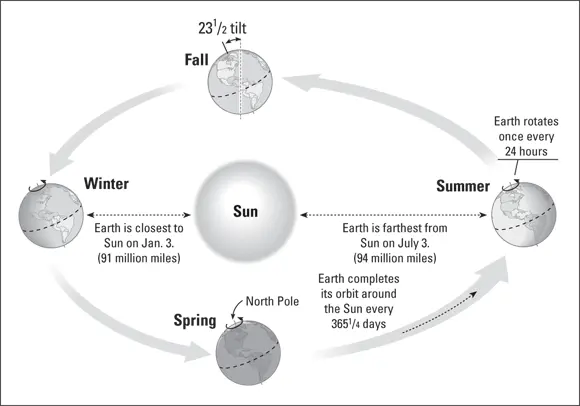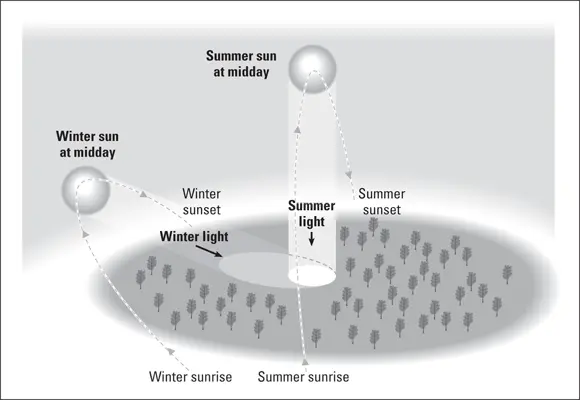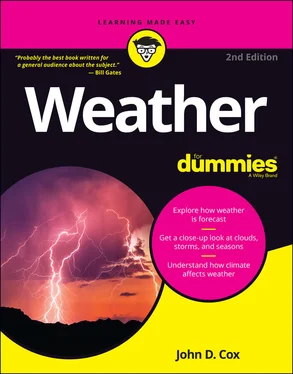Another kind of vertical mixing known as free convection depends on buoyancy — the ability of warmer air to rise in cooler air. In the atmosphere, a kind of bubble of warm air is formed near the surface and floats up to higher altitude, above the cooler, denser air around it, much like a hot-air balloon would do. As it rises higher and higher, the bubble of air expands, and as it expands, it cools. This kind of rising and falling of air of different temperatures and densities is going on all the time.
The process of free convection can be especially noticeable on a warm summer afternoon. The Sun is heating the ground and the heat from the ground is quickly warming the air just above it. Before long, a rising column of warm expanding air is formed. These are the thermal updrafts that soaring birds ride on a warm day.
If conditions are right, if the air bubble contains enough moisture and the surrounding air is colder than the bubble of air, a cloud can eventually form when the rising air gets cold enough for its water vapor to condense into tiny liquid droplets or even ice crystals. (For more about cloud formation, see Chapter 6.) This condensation process gives off still more heat, called latent heat. This latent heat plays a major role in the in the formation of clouds and storms. (See the sidebar, “How to cause a storm.”)
 You want to know what’s really behind all that turbulent mess you think of as weather? (No, my people at the Go Figure Academy of Sciences have looked into it, and they tell me it’s not the government.) Do you want the Big Picture? Well, now it can be told. Believe it or not: It all has to do with the way the solar system is put together. (Hey, you wanted the Big Picture!)
You want to know what’s really behind all that turbulent mess you think of as weather? (No, my people at the Go Figure Academy of Sciences have looked into it, and they tell me it’s not the government.) Do you want the Big Picture? Well, now it can be told. Believe it or not: It all has to do with the way the solar system is put together. (Hey, you wanted the Big Picture!)
When you really get down to it, three large facts of life in this particular reach of the solar system are responsible for the behavior of Earth’s atmosphere. You can see them all in Figure 3-5. It has to do with the orbit of the Earth around the Sun. It has to do with the way the planet rotates on its own axis, the way it spins like a top. And it has to do with the fact that it is not spinning straight up and down, but at a tilt. Also, notice how the Earth is closest to the Sun on January 3, in the middle of the Northern Hemisphere’s winter. Go figure!

FIGURE 3-5:The Big Three behind the weather on Earth: its yearlong orbit around the Sun, its tilt that gives the year its seasons, and its daily rotation.
Long live the revolution!
If you told me that it takes a year for the Earth to travel completely around the Sun, and that a year is 365 days, you would be accurate enough for most purposes. But I might not want to set my clock by yours. Did you remember Leap Year — the fact that you add a 29th day to February every four years? This makes up for the fact that the complete revolution of Earth’s orbit around the Sun actually takes 365¼ days.
There’s something else about Earth’s orbit of the Sun that is a little, well, irregular. If you look at it closely, you will see that it is not really a circle — that is, the Sun is not in the center of Earth’s orbital path. Instead, it is off to one side. The shape of the orbit is elliptical, which means that at some times during the year the Earth is actually closer to the Sun than at other times.
This state of affairs might lead you to think — as some people do — that Earth’s elliptical orbit is responsible for the fact that some times of year are warmer than others — that summer might be caused by the fact that the Earth and Sun are closest together at that time of year. This is a completely mistaken idea, and you should wash it out of your mind immediately. In fact, I’m sorry I brought it up!
If you have any doubts, consider this fact: The Earth is closest to the Sun every year on January 3. I don’t know about you, but I live in California, and while we have had some pretty nice January days, January 3 has never felt much of anything like summer. If I lived in the Southern Hemisphere, south of the Equator, where January 3 is in the summertime, I might think differently about this, of course. But still I would be wrong. Earth being closest to the Sun at that time of year is not responsible for the fact that it is summertime there either.
Here’s what it means: On or about January 3, the Earth and the Sun are a mere 91 million miles apart. Six months later, on July 3, at the opposite side of the elliptical orbit, when they are farthest apart, the distance has stretched to 94 million miles. This is about a 3 percent difference in the Earth-Sun distance from one time of year to another.
It has an impact on the intensity of sunshine reaching Earth, no doubt about it. Scientists have figured out that Earth gets 7 percent more heat energy from the Sun on January 3 than it does on July 3. This is because on July 3, even though it is mid-summer in the Northern Hemisphere, the sun’s rays are traveling a little farther and so are slightly more spread out than they are on January 3. But this small difference does not account for the seasons. The angle that they strike a particular place on Earth makes a lot more difference to the intensity of the Sun's rays. As Figure 3-6 illustrates, the angle is what the seasons are all about.

FIGURE 3-6:In the Northern Hemisphere’s summer, the Sun’s rays are more intense as they strike the atmosphere more directly overhead, while in winter they strike at a greater angle and travel through more atmosphere.
The closer together the rays of sunshine, the more intense the energy. This idea helps explain why the energy from the Sun is weaker when it shines on the polar regions of Earth than at the Equator. These regions remain cold even though the Arctic and Antarctica, at the North and South Poles, get many hours of daily sunshine during the summers in the Northern and Southern Hemispheres. It has to do with the angle at which the sunlight strikes.
 Try this at home. Notice how much brighter a flashlight’s beam is when it is shining directly at a surface and how quickly it fades when you spread the beam out at a greater angle and over a bigger area.
Try this at home. Notice how much brighter a flashlight’s beam is when it is shining directly at a surface and how quickly it fades when you spread the beam out at a greater angle and over a bigger area.
Everybody notices this effect of the sunshine between the different seasons, of course. Unless they live in the Tropics, the region of the world along the Equator, where the Sun is more or less directly overhead all year long. For most of the world, the winter Sun that comes glancing in at a low angle is a pretty weak sister to the summer Sun that spends a lot of time directly overhead. Figure 3-7 illustrates the point. The next section of this chapter explains the cause of this seasonal angle.
Hmmm … let me see now… .
The time from the Summer solstice to the Winter solstice would be — yup, that checks out, 182 and 183 days between them, close enough.
And from the spring equinox to the autumnal equinox — oops, what’s going on here? Between March 20 and September 22 are 186 days, and between September 22 and March 20 are 179 days.
Читать дальше

 You want to know what’s really behind all that turbulent mess you think of as weather? (No, my people at the Go Figure Academy of Sciences have looked into it, and they tell me it’s not the government.) Do you want the Big Picture? Well, now it can be told. Believe it or not: It all has to do with the way the solar system is put together. (Hey, you wanted the Big Picture!)
You want to know what’s really behind all that turbulent mess you think of as weather? (No, my people at the Go Figure Academy of Sciences have looked into it, and they tell me it’s not the government.) Do you want the Big Picture? Well, now it can be told. Believe it or not: It all has to do with the way the solar system is put together. (Hey, you wanted the Big Picture!)

 Try this at home. Notice how much brighter a flashlight’s beam is when it is shining directly at a surface and how quickly it fades when you spread the beam out at a greater angle and over a bigger area.
Try this at home. Notice how much brighter a flashlight’s beam is when it is shining directly at a surface and how quickly it fades when you spread the beam out at a greater angle and over a bigger area.










